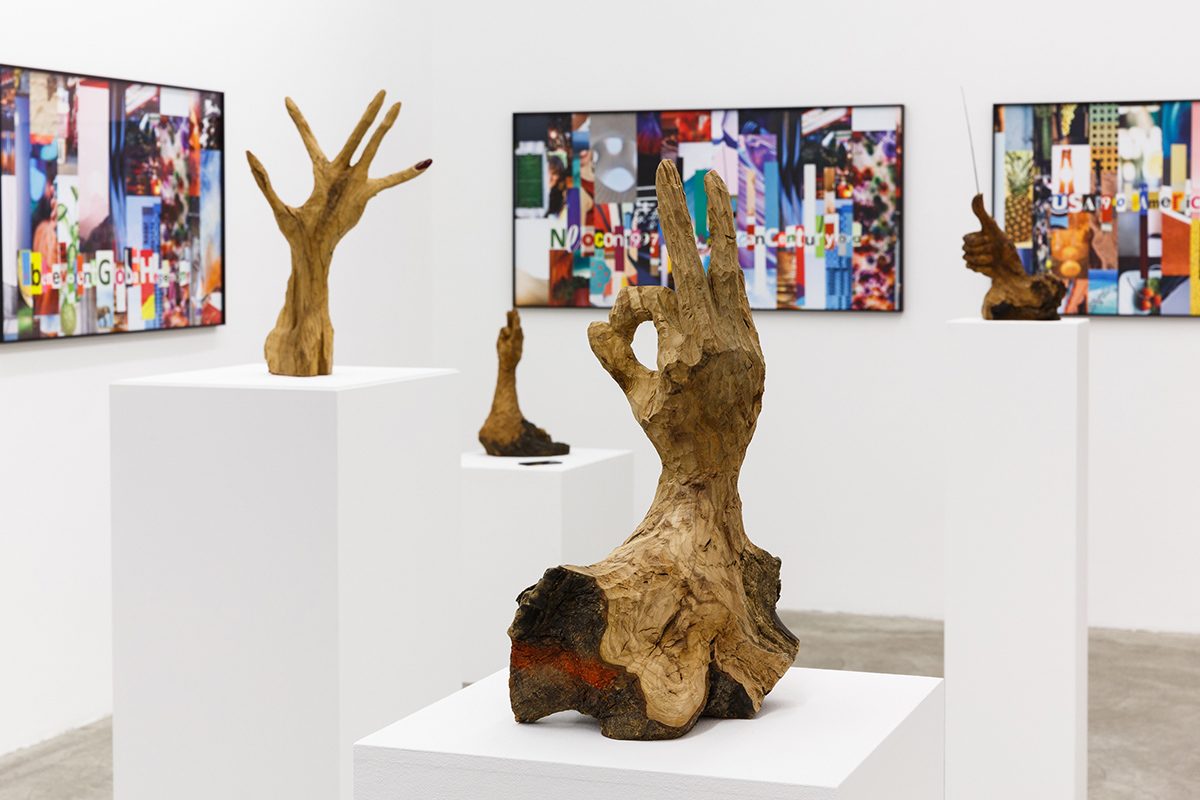All the Lands from Sunrise to Sunset transforms classic imperialist maxims into hashtags
Named after ancient Mesopotamian king Sargon of Akkad’s bold claims about the extent of his rule, this exhibition crams 25 works, including colourful paper collages, sculptures, installations, found objects and a video – the fruits of four series and three collaborations from 2004 to 2019 – into all three floors of the gallery. The titular paper collage series (2018), video installation Chronoscope 1952 or 1953 11pm (1) (2012–17) and Ian’s Gulf (maps version) (2018) are clearly part of the Venezuelan-born, Berlin-based artist’s critique of cultural imperialism. In other works, this is brought to bear on contemporary art production per se.
Edward W. Said justified the limited scope of his essay collection Culture and Imperialism (1993) by referring to the ‘unique coherence and special cultural centrality’ of British, French and American imperialism. With the title series, Balteo-Yazbeck displaces some of these expectations by going further back into history, turning classic imperialist maxims from ancient Egypt, Mesopotamia, Persia and more into email addresses and hashtags. He does so using familiar typefaces from consumer goods against a background of fragments from fashion magazines, holiday snaps and stock photos, like an extravagant ransom note. Some titles refer to imperialist projects that saw themselves as Sargon of Akkad did (cesar@marenostrum.ad, britain1821@sunneversets.co.uk), but others – #benevolentglobalhegemony, #encodingworlddominationgenealogy and dominion@planet.com – point to continuities between earlier empires and neoconservatism or today’s Silicon Valley ideology. Each piece’s fractured, patchwork feel mimics how empires impose powerful interests (gods, laws, economic activity) on diverse groups. By inviting us to look at ancient empires using the visual codes of the present, Balteo-Yazbeck suggests that today’s networked culture gives the world a more uniform look than any historical empire despite its eclectic style.

The collages line the walls of the shorter part of the gallery’s L-shaped main space. Five sculptures made from olive wood, o.k., Nail Polish 3000 bc, gps 1973, Opposable Thumb and Carving Coal Since 4000 bc (all 2018), irreverently modified remakes of works by an artist identified as Attilio Napolitano, stand on cylindrical plinths in the middle. These uncanny handlike figures grasping the air are like ghouls trying to escape a graveyard; or warnings against trespass from some deep forest, repurposed with a folk-art feel. And though the lacquer applied to Nail Polish 3000 bc updates something ancient-looking, the macabre imperialism/artistic-domination connection is clearer when the source material is more recent. Comfort (2019), for example, based on an adjustable chaise longue designed by Ludwig Mies van der Rohe in 1927 and made partly from solar panels and electronic components connecting it to a contemporary Ikea stool based on an Alvar Aalto design, suggests a link between intellectual property and classic critiques of hegemony. This continues upstairs with Warao Chinchorro / Hammock (Water-Oil) (2004–14) – a hammock woven by members of the Warao people (indigenous to the Orinoco Delta) with a framed 2010 untitled pigment print by still-life photographer Holger Niehaus lying in it – implicating contemporary art in that critique.
The connection is solidified downstairs. Chronoscope 1952 or 1953 11pm (1), a CBS public affairs show about early Cold War American military interests – which the artist has playfully defaced by digitally overlaying pink and green ink on the presenters’ eyes and mouths – faces Ian’s Gulf (Maps Version), two individually framed maps of the Middle East taken from a 1951 edition of Fortune magazine, indicating strategic geographies and available raw materials in the same colours. Balteo-Yazbeck’s point, evidently, is this: imperialist extractivism treats the world as a resource to be marketised, but that greedy process is also at play in the conceptual vampirism of contemporary art itself.
Alessandro Balteo-Yazbeck, All the Lands from Sunrise to Sunset, Galerie Martin Janda, Vienna, 17 January – 29 February
